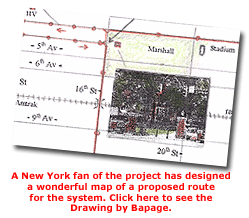|
INTRODUCTION
Purpose
 |
|
Vintage
postcard from Huntington showing trolley on Fourth Avenue
|
This report contains
the results of a study undertaken by Sam St.Clair on behalf of the
Huntington Electric Trolley Association (HETA), of Huntington, West
Virginia, to assess the feasibility of constructing and operating
a vintage streetcar line on Huntington's Fourth Avenue. The study
examines the appropriateness and historical context of a rail-based
streetcar system designed to provide a transit alternative to the
visitors, students, and residents. It
provides information on similar undertakings, both in operation
and planned, in other localities. It analyzes the problems and opportunities
of installing the system along an alignment where streetcars once
operated. It develops capital and operating cost estimates and suggests
funding sources. Finally, it recommends actions which should be
undertaken to move the project forward.
Project Goals
To provide information
on comparable operating and planned vintage streetcar systems in
cities throughout the United States.
- To
suggest a specific route and alignment for a vintage streetcar
system in Huntington.
- To
evaluate various vehicle technologies and recommend a suitable
vehicle.
- To
develop a range of operating scenarios.
- To
provide rough order of magnitude capital costs for the system.
- To
provide estimates of annual operating costs for various operating
scenarios.
- To
provide information on available funding sources.
- To
provide an outline of steps by which the project could be implemented.
Key Project Issues
 The
most significant technical issue for the proposed streetcar system
is that of fitting a suitable alignment into Fourth Avenue's development.
Realizing that the street cannot be significantly widened, its 60'+/-
typical width precludes a bi-directional streetcar track. The proposed
alignment will require adjustments in traffic flow and/or parking
availability. Thus, it is important that the issue be thoroughly
aired and a workable consensus reached by the community. The
most significant technical issue for the proposed streetcar system
is that of fitting a suitable alignment into Fourth Avenue's development.
Realizing that the street cannot be significantly widened, its 60'+/-
typical width precludes a bi-directional streetcar track. The proposed
alignment will require adjustments in traffic flow and/or parking
availability. Thus, it is important that the issue be thoroughly
aired and a workable consensus reached by the community.
A second key issue
is that of funding. Many vintage trolley systems are in cities where
the population and tax base are of a size that raising local funds
to match State and Federal dollars is fairly straightforward. The
local population of Huntington is clearly not of this magnitude.
This calls for very creative financing, and may require a larger
than usual Federal and State role.
This expanded
role may be justified, however, when the purpose of the system is
considered. Although it is expected that local residents, and Marshall
University students will use the line, it is our hope that a major
portion of ridership will come from visitors. In serving these markets,
the streetcar is intended to preserve the irreplaceable character
of the Historic Downtown District, while reducing auto traffic and
associated negative environmental impacts. This goal puts the project
within the overall eligibility guidelines for Federal transit assistance
under recently-enacted legislation. In addition, the undeniable
value of the Downtown District as a visitor venue, and the desire
to preserve it, is consistent with other Federal programs which
are developing non-auto transportation projects to preserve and
enhance the attractiveness of urban communities.
|















